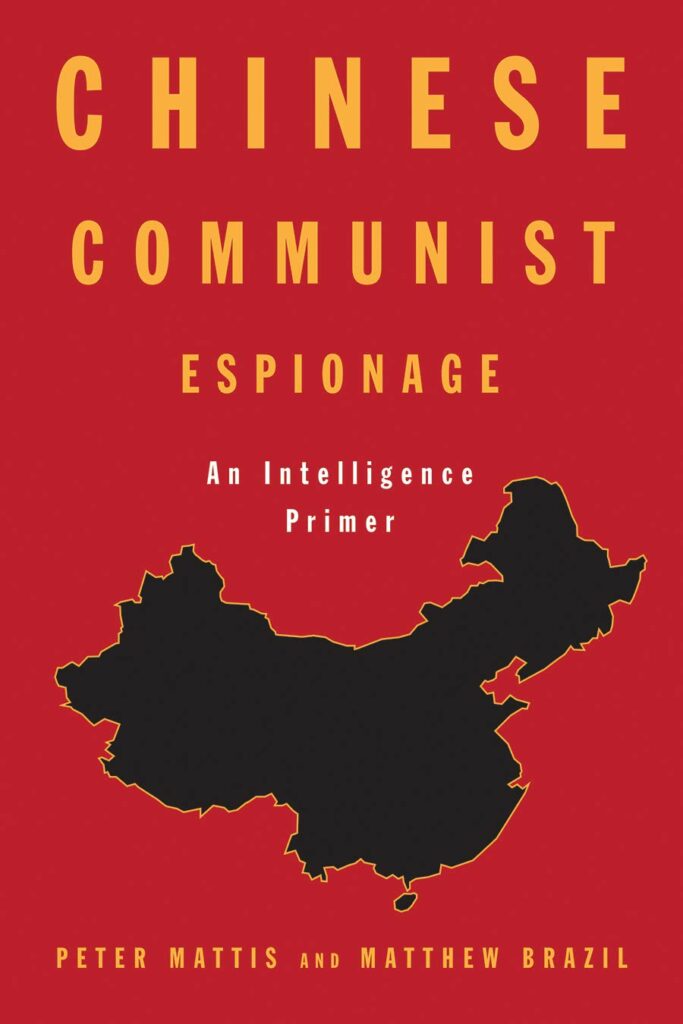
Review of Chinese Spies: From Chairman Mao to Xi Jinping by Roger Faligot. Hurst, 2019, and Chinese Communist Espionage: An Intelligence Primer by Peter Mattis and Matthew Brazil. Naval Institute Press, 2019.
“What enables the wise sovereign and the good general to strike and conquer, and achieve things beyond the reach of ordinary men, is foreknowledge … hence the use of spies,” Sun Tzu observed. Two fascinating new books add to our understanding of the history and methods of China’s intelligence services.

The Chinese Communist Party’s intelligence apparatus was heavily shaped by the civil war with the nationalist KMT for control of the country. CCP intelligence, in the form of the Special Operations Work Department, was created following the Party’s near destruction in a vicious 1927 crackdown. But within just four years, CCP intelligence had infiltrated the KMT so effectively that it was able to warn against multiple subsequent crackdowns, saving the lives of future leaders such as Zhou Enlai, and allowing the party to fight on to victory.
Today, China’s espionage efforts are led by the Ministry of State Security, its civilian intelligence agency, and the military. (Other agencies also have responsibility for open-source intelligence and political influence efforts.) Compared to other nations, China’s covert efforts are unique in at least two respects. The first is the vast scale of its technological and economic espionage efforts, targeting not just technologies of interest to its military, but tech that can also advance the country’s economic leadership. The second, rooted in its Marxist-Leninist history, is its extensive use of “united front” work – the subtle co-option or coercion of foreign persons and actors to project the country’s influence and advance its strategic interests. The tremendous and arguably greater covert efforts directed towards maintaining internal security should also be acknowledged.
Chinese Spies is the work of Roger Faligot, a French journalist who has written on the subject for decades; the new English edition is an updated version from the 2008 French version. It is a work of professional passion bordering on the obsessive – even the seafood allergy of one military intelligence official’s wife does not escape Faligot’s attention. The full impact of the many captivating digressions is diminished somewhat by the disorienting impact of Faligot’s inconsistent regard for chronology.
Apart from the Communist Party’s turbulent internal politics, Faligot’s coverage of the CCP intelligence’s presence in colonial Hong Kong and Macau makes for particularly engaging reading. Faligot also excels in mapping out the close family ties in Chinese politics, the security services’ relationship with organized crime, and the persistently central – yet under-examined – role of secret societies and Chinese of Hakka descent throughout the party’s history.
Chinese Communist Espionage, written by Peter Mattis and Matt Brazil, the former, an ex-CIA analyst, and the latter, an ex-Asian hand for the US government, is a more narrowly defined effort. Structured as a “primer,” the book offers an index of short vignettes on key persons and episodes in the history of Chinese espionage, drawing extensively on Chinese language sources, and inviting readers to “draw their own conclusions about PRC intelligence services, their activities, and their methods.” The book’s tight sourcing – or at least clearer acknowledgment of the relative confidence in the veracity of different elements of information – sets a standard by which Faligot can be criticized for falling short.
Even as the Mattis and Brazil effort eschews synthesis (and, again, chronological order), their work nonetheless offers important insights and underlooked stories. Among these are Mo Xiong, a KMT general and communist spy, who got word out of an impending campaign to crush the CCP Red Army, precipitating the Long March.
Mattis and Brazil’s comprehensive documentation of US economic espionage cases, from agriculture and chemicals to high-tech chips, underscore that few industries are outside the scope of Beijing’s interests. That these generally represent only cases brought to prosecution causes one to shudder at the prospect of the many others that have gone undetected. (Jail sentences generally under a few years in length also cause one to question whether tougher sentencing might be a more effective deterrent.)
Both books’ emphasis on human intelligence, rich in drama though it may be, obscures the vast and aggressive cyber-espionage efforts also taking place. Insights on how intelligence informs China’s leaders and the country’s policymaking process is also regrettably limited, as are examples beyond Western targets of Chinese espionage. Mattis and Brazil do, however, offer many examples related to Taiwan. The West’s reciprocal efforts to spy on China are also generally out of scope for both books. In other fora, Mattis has noted that fewer Chinese officials have defected compared to the Soviet Union and its counterespionage has proven fiendishly robust.
Mattis has elsewhere offered a broader assessment of Chinese intelligence and its shortcomings, characterizing their work as “heavily politicized” and “stove-piped.” Most Chinese intelligence operations are launched within the country, meaning that its intelligence collection is strongest with respect to its own country, but likely to be less robust on what countries are thinking and doing elsewhere. The implication is that of a rising and increasingly exposed global power that perhaps knows less about what is going on in the world than it should.
In one of Faligot’s more humorous asides, in the 1980s a French businessman called his boss from the heavily monitored Beijing Hotel. As the two spoke in their native Breton, a Chinese spy eavesdropping on the call interjected demanding that they speak French. As both books make clear, China’s intelligence services have come a long way in their sophistication. But to what end remains unclear. In the West, it is said of the intelligence community that its ‘successes are unheralded, its failures trumpeted.’ In China’s opaque system, we know enough to know how much we don’t.